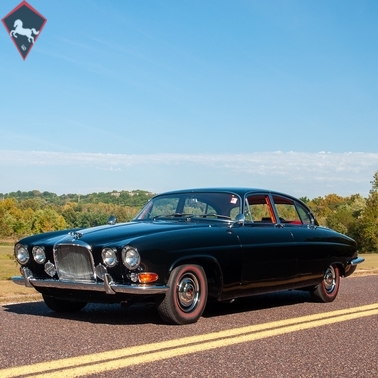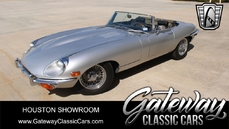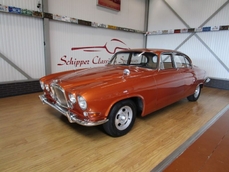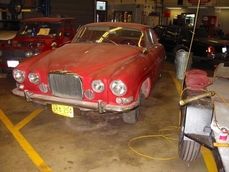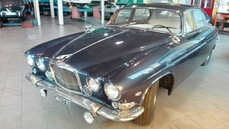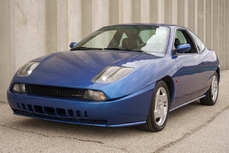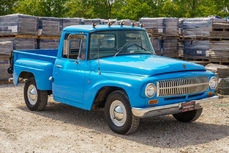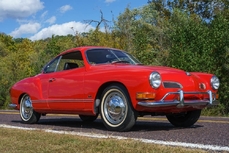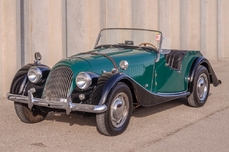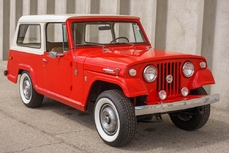Jaguar MK X 3.8L straight six 1964
Allmän beskrivning :
1964 Jaguar Mark X Saloon
Previously owned/titled by real estate mogul Richard Parkoff of the Parkoff Organization
Parkoff commissioned a no expense spared restoration on this Mark X in Southern Florida
One of 5,775 Mark Xs exported in 1964
First Jaguar Saloon to feature independent rear suspension
Black exterior with rich red leather interior
3.8L inline six-cylinder engine with triple SU carburetors
Borg-Warner DG 250 three-speed automatic transmission and 3.54 gearing
Air-conditioning, power steering, power four-wheel disc brakes and power windows
Rear seats feature fold-down trays and fold-down center armrest
Redline Coker Classic tires to match the red interior
Comes with Jaguar Daimler Heritage Trust certificate
Own this Vehicle from $639 per month-call 636-600-4600
Seeking a classic British Executive Luxury Saloon finished in desirable black exterior and rich red leather interior that has benefited from a no expense spared extensive restoration by Mr. Executive himself, real estate tycoon Richard Parkoff! MotoeXotica Classic Cars is pleased to present this handsome 1964 Jaguar Mark X Saloon.
Made on March 16, 1964 at Jaguar’s Coventry, England factory, . It was dispatched on April 7, 1964 via Jaguar Cars in New York, NY. With the most recent owner being Richard Parkoff of the Parkoff Organization, a massively successful New York City real estate firm. In 2008 the Parkoff Organizaion making headlines with New York City’s largest ever all-cash deal in real estate. Since then the organization has made multiple other multimillion dollar deals in and around New York City. Making the Parkoff Organization one of the premier real estate firms in New York City.
With money being no object, about 10 years ago, the car was repainted and reupholstered – the exterior is finished in a stunning black exterior while the interior is finished in rich red leather that absolutely smells wonderful. The paint and trim are in excellent overall condition. The windows are clear and intact while the car’s lights are haze-free and intact. The car’s bodywork is straight and solid including the chrome bumpers.
The area under the bonnet (hood) is extremely tidy, the battery appears new while the boot (trunk) is in very good overall condition, complete with full-sized spare tire and cover. This classic cat rolls on Coker Classic redline tires, size P195/70R14 at all four corners and each tire is mounted on a steel wheel topped with factory wheel cover. The tires and wheel covers are all in very good order.
Under the hood is Jaguar’s venerable 3.8L straight six motor breathing via triple SU carburetors and dual exhausts and backed by a Borg-Warner DG250 three-speed automatic transmission and a 3.54:1 rear end. Driver convenience features include air-conditioning, power steering, power four-wheel disc brakes and power windows.
Inside, the car’s red leather interior is quite eye-catching and complements the exterior well. The supple leather is very inviting and the burled walnut accents on the door panels, instrument panel and center console inject warmth. The front and rear seats are in excellent shape, as is the matching carpet. The factory two-spoke steering wheel is present and looks great. The dashboard and inner door liners are in nearly impeccable condition. Even the center console looks fantastic. The interior was Jaguar’s last to feature abundant standard woodwork, including the dashboard, escutcheons, window trim, a pair of large bookmatched fold out rear picnic tables, and a front seat pull-out picnic table stowed beneath the instrument cluster.
The Jaguar Mark X (Mark Ten) was British manufacturer Jaguar’s top-of-the-range saloon for a decade, from 1961 to 1970. The large, luxurious Mark X succeeded the Mark IX as the company’s top saloon model and was primarily aimed at the United States market. The company hoped to appeal to heads of state, diplomats and film stars.
Introduced in the same year as Jaguar’s iconic E-Type, the Mark X impressed with its technical specification and innovations. Contrary to its predecessors, the car featured integrated, unitary bodywork – the largest in the UK at the time, as well as independent rear suspension, unheard for early 1960s British luxury cars. Combined with the 3.8-litre, triple carburetor engine as fitted to the E-type, it gave Jaguar’s flagship a top speed of 120 mph and capable handling at less than half the price of the contemporary Rolls-Royce Silver Cloud.
Despite press acclaim from both sides of the Atlantic, the Mark X never achieved its sales targets. When Jaguar decided to replace its entire saloon range with a single new model, the resulting XJ6 of 1968 used the Mark X as a template – albeit with a reduced size.
In 1961, the Mark X introduced a new upright, and slightly forward-leaning nose design for Jaguar saloons, with four headlamps set into rounded front fenders (derived from Daimler DK400), and a vaned grill. This front-end style reappeared on many of the manufacturer’s successive saloons, up to and including the X-Type and third generation Jaguar XJ, both through 2009 — thereby forging Jaguar saloons’ look for half of a century. In 2008, Jalopnik called the quad round headlight design the classiest headlight configuration and the fourth-best car design element of all time, mentioning Jaguar specifically.
Instead of relying on body-on-frame construction, like its predecessors and most of its competitors, the Mark X received a unitary construction monocoque body-shell, codenamed “Zenith” during its development. The substantial doors required helical torsion springs inside the door pillars to enable them to be opened from the inside with a low level of effort.
From its introduction in mid-October 1961 until the arrival in 1992 of the low-slung XJ220, the Mark X stood as one of the widest production Jaguars ever built. Asked in 1972 if he thought the Mark X had grown too large, Jaguar chairman William Lyons agreed that it “definitely” had: he opined that the then recently introduced and notably more compact Jaguar XJ6 was, by contrast an “ideal size.”
The Mark X was the first Jaguar saloon to feature independent rear suspension. It differed from earlier large Jaguar saloons in having 14” wheels instead of the more common 15”. It used a wider-track version of Jaguar’s IRS unit first seen on the E-Type, which was subsequently used on Jaguar vehicles until XJ-S production ended in 1996. The front suspension used double wishbones with coil springs and telescopic dampers.
Power initially came from the E-type’s version of Jaguar’s XK inline six-cylinder engine. A 9:1 compression ratio was standard but an alternative 8:1 compression ratio was available as an option. Triple SU carburetors were fitted, fed from an AC Delco air filter mounted ahead of the right-hand front wheel.
Transmission options were manual, manual with overdrive, automatic, or automatic with overdrive. Many domestic market cars and all cars destined for the important North American markets left the factory with a Borg Warner automatic gearbox.
Stopping power for this heavy car came from power-assisted disc-brakes on all four wheels and power-assisted steering was standard.
Documentation includes a Jaguar-Daimler Heritage Trust Certificate and more than $4K in receipts from Mr. Parkoff’s restoration in Florida.
Competition to this Jaguar in 1964 included BMW’s New Class Sedan, Cadillac’s Sedan de Ville, Chrysler’s 300, Mercury’s Park Lane, Oldsmobile’s 98 and Mercedes-Benz’s 600.
Whether you’re a head of state, diplomat or a movie star or not, you should visit MotoeXotica Classic Cars to check out this classic, full-size Jaguar. You won’t see many ‘60s Jaguars on the road, at the car show or cruise night.
VIN: 353588BW EIN: ZB4067-9 TIN: JX10518P BIN: Z13124
This car is currently located at our facility in St. Louis, Missouri. Current mileage on the odometer shows 53,813 miles. It is sold as is, where is, on a clean and clear, mileage exempt title. GET OUT AND DRIVE!!!
Copy & Paste the Link Below to View Our YouTube Video:
https://youtu.be/38DYlGgGRbM
https://www.motoexotica.com/inventory/listing/1964-jaguar-mark-x/
1964 Jaguar MK X 3.8L straight six is listed såld on ClassicDigest in Fenton (St. Louis) by for $42900.
Fakta i bilen
Karosstyp : Personbil Märke : Jaguar Modell : MK X Modellversion : 3.8L straight six Motorvolym : 3.8 Årsmodell : 1964 Karosstyp : Sedan Läge : Fenton (St. Louis)
Såld
Information om säljaren
Såld
People who viewed this Jaguar MK X also viewed similar Jaguar listed at ClassicDigest
Other cars listed for sale by this dealer
om Jaguar
Åh, historien om Jaguar, från dess tidiga dagar som SS Cars Ltd. till sin höjdpunkt med D-typen och gatubilsevolutionen i form av den ikoniska E-typen. Det finns något alldeles brittiskt över denna berättelse, och jag ska berätta den som en brittisk journalist skulle göra.
I början:
Vår resa in i Jaguar-världen börjar på 1930-talet, när ett företag som kallades SS Cars Ltd. dök upp. Trots den olyckliga sammanträffandet av deras initialer med de stigande politiska spänningarna i Europa började de producera stilfulla och prestandainriktade bilar. SS 100, som introducerades 1936, var en symbol för elegans och hastighet och lade grunden för vad som skulle bli Jaguar.
Jaguars födelse:
När skuggan av andra världskriget närmade sig beslutade SS Cars Ltd. klokt att distansera sig från SS-initialerna. Så 1945 blev de officiellt Jaguar Cars Ltd., ett namn som snart skulle bli synonymt med brittisk lyx och prestanda.
XK-serien:
Jaguars efterkrigstid gav oss XK 120, en verklig sensation 1948. Med sin strömlinjeformade design och en kraftfull 3,4-liters raksexmoters blev den världens snabbaste seriebil. XK 120 var ritningen för det som komma skulle - Jaguar som förenade stil med hastighet på ett unikt brittiskt sätt.
D-typens dominans:
Sedan kom D-typen, en sann racinglegend. Introducerad 1954, vann den Le Mans tre gånger på 1950-talet och visade Jaguars tekniska skicklighet. Med sin innovativa monokokkonstruktion och den ikoniska fenan bak var D-typen höjdpunkten av Jaguars framgång inom motorsport.
E-typens framträdande:
Men den verkliga vändpunkten kom 1961 med introduktionen av E-typen, ofta beskriven av Enzo Ferrari som "den vackraste bilen som någonsin byggts". Dess långa motorhuv, böljande kaross och en 3,8-liters motor som levererade upphetsande prestanda gjorde den till en omedelbar klassiker. E-typen var inte bara en bil; den var ett konstverk på hjul och kunde nå 150 mph på vägen.
Gata och racingsuccé:
E-typens skönhet matchades av dess förmåga på racerbanan. De lätta E-typarna var särskilt framgångsrika i olika racingevenemang och cementerade Jaguars rykte som en kraft att räkna med inom motorsport.
Raffinemangets ålder:
När vi fördjupar oss i Jaguar-historien finner vi att 1950-talet och 1960-talet var en tid av raffinering och expansion. Tillsammans med den magnifika D-typen och den ikoniska E-typens framträdande introducerade Jaguar modeller som ytterligare befäste sitt rykte för lyx och prestanda.
MK2:
I slutet av 1950-talet presenterade Jaguar MK2, en sportig sedan som kombinerade elegans med kraft. Denna eleganta fyradörrars salong var en favorit bland bankrånare och polisen, tack vare dess exceptionella hastighet och hantering. MK2 var en symbol för Jaguars förmåga att förena sofistikering med prestanda och hade också en framgångsrik racingkarriär.
XJ6:
Hoppa fram till 1968 och Jaguar lanserade en bil som skulle definiera lyxbilar i decennier framöver - XJ6. Det var ett mästerverk i teknik och design med en jämn raksexmoters, oberoende bakre fjädring och en rymlig, vackert inredd interiör. XJ6 var en symbol för brittisk elegans och erbjöd en så smidig åktur att det kändes som om den gled över vägen. Den blev flaggskeppsmodellen för Jaguar och satte standarden för lyxbilar och visade en nivå av raffinering som imponerade på konkurrenterna.
Blandningen av klassiskt och modernt:
Medan MK2 och XJ6 representerade utvecklingen av Jaguars sedanmodeller, bibehöll de märkets engagemang för prestanda och lyx. Dessa bilar hörde inte bara hemma på racerbanan; de trivdes lika bra på de stora boulevarderna som på en avslappnad körning genom den engelska landsbygden.
Utmaningarna av förändring:
Men när 1970-talet närmade sig, ställdes Jaguar, liksom många brittiska biltillverkare, inför ekonomiska utmaningar och ägarförändringar. British Leyland-eran förde både möjligheter och svårigheter med sig när varumärket navigerade genom olika sammanslagningar och övergångar.
Ändå fortsätter arvet från MK2 och XJ6, tillsammans med D-typen och E-typen, att definiera Jaguar som en tillverkare som förenar tidlös elegans med en anda av prestanda. Dessa klassiska modeller, vare sig de körs på slingrande vägar eller står som samlarföremål, tjänar som ett vittnesbörd om Jaguars långvariga närvaro inom den automobila exklens värld.
Jaguar-historien, från dess tidiga dagar som SS Cars Ltd. till skapandet av ikoner som E-typen, MK2 och XJ6, är en resa som speglar essensen av brittisk bilkultur - en blandning av lyx, kraft och stil som fortsätter att fängsla entusiaster och samlare över hela världen.
